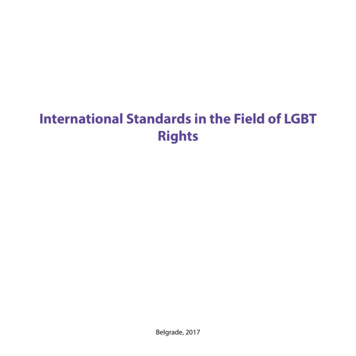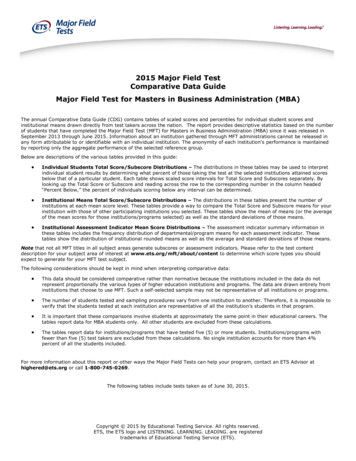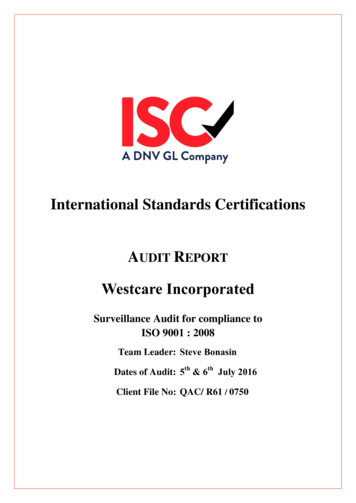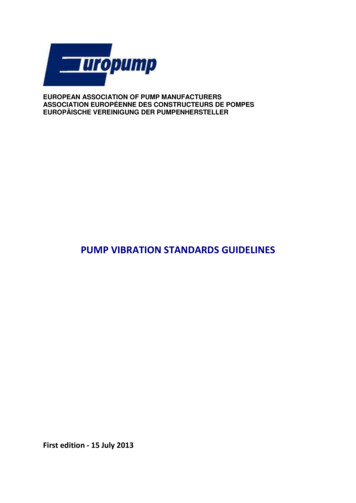
Transcription
International Standards in the Field of LGBTRightsBelgrade, 2017
This publication was made possible with the support of the American people through the United States Agency forInternational Development (USAID). The views expressed herein are those of Labris - the Organization for Lesbian HumanRights and do not necessarily reflect the views of USAID or the United States Government.
ContentsIntroduction7International system for the protection of human rights11Universal instruments for the protection of human rights11Documents and mechanisms for the protection of human rights of the Council of Europe25Legislation and European Union policies for the protection of LGBT rights34Documents by the Organization for Security and Co-operation in Europe (OSCE)36
Introduction“Those who are lesbian, gay or bisexual, those who are transgender, transsexual or intersex, are full and equal membersof the human family, and are entitled to be treated as such.”High Commissioner for Human Rights at the United Nations 2008-2014Mrs. Navanethem PillayWhen discussing the rights of lesbian, gay, bisexual, transgender and intersex (LGBTI) people, we do not talkabout any special rights they are entitled to, apart from the existing corpus of human rights. We are talking aboutthe same, universal rights which should apply to every individual anywhere in the world. The rights of LGBTI peopleshould be protected in the same way as are the rights of all other people and no right should be denied to them.In the last couple of years, many states have made a significant effort in strengthening the protection of humanrights of LGBT people – from passing anti-discrimination laws, punishing hate crimes committed against LGBT people, educating public officials, acknowledging same-sex relationships and marriages to the extent of enabling samesex couples to adopt children. Unfortunately, there are other states, systems, traditions and customs where even theright to live is being denied only because someone is a member of the LGBTI community.International bodies, whose members we are (United Nations and the Council of Europe) or are striving to become (European Union), play an important role in shaping policies for the protection of every individual. However,those belonging to minority communities and their associations play an even larger role. The history of humanrights is the history of marginalized groups. Their continued struggle testifies to the fact how far away the world isfrom the proclaimed universality of human rights.The existing international system for the protection of human rights also protects the rights of LGBTI people,although not always in such an obvious manner. There are often specific actions and measures necessary in orderto secure their full enjoyment of rights. Not one of the binding instruments of the United Nations for the protectionof human rights (Conventions and Pacts) is dedicated exclusively to the rights of LGBTI people, nor are the LGBTIpeople directly mentioned in them. However, through the mechanisms for the application of these instruments, thecorpus of international rights has started to see its application in cases of violating the rights of LGBT people, whichstarts changes and shapes policies. The issue of LGBTI people’s rights is slowly entering the system of the UnitedNations, through resolutions in which they appear “bashfully” at first and with a lot of resistance, only to have thematical reports dedicated to this topic in recent years. The role of the Human Rights (HRC) and the United NationsOffice of the High Commissioner for Human Rights (OHCHR) is indisputable in this process, as well as the role civilsociety organizations play.7
The following text is an attempt at consolidating the existing international legislation in the area of human rightsprotection according to different sexual orientation and gender identity. Parallel to that, we hoped to present a review of the compatibility of domestic legislation, policy and actions for protecting the human rights of LGBT peoplein Serbia with international standards, and to present guidelines and recommendations and point at the protectionof these rights.In addition to the overview of binding international documents, there is also an overview of relevant declarations, recommendations and resolutions which, although not legally binding, offer guidance, recommendationsand guidelines for states as well as activists. We have selected several documents which we present in their entirety,since they represent advocating instruments and give clear instructions regarding the rights of LGBT people. Thesedocuments are: Yogyakarta Principles for the implementation of the international framework for human rights protection regarding sexual orientation and gender identity;1 EU Guidelines to promote and protect the enjoyment ofall human rights by LGBT persons2 and the Recommendation by the Council of Europe CM/Rec (2010) 5 on measuresto combat discrimination on grounds of sexual orientation or gender nciples en.pdf2Council of the European Union, Guidelines to promote and protect the enjoyment of all human rights by LGBT persons, Luxembourg, 24June 2013.3Recommendation CM/Rec (2010) 5 of the Committee of Ministers to member states on measures to combat discrimination on groundsof sexual orientation or gender identity, Adopted by the Committee of Ministers on 31 March 2010 at the 1081st meeting of the Ministers’Deputies.8
9
10
International System for the Protection of Human Rights1. Universal instruments for the protection of human rightsThe story of the human rights started with the founding of the United Nations and passing the Charter of theUnited Nations in 1945,4 which established the aims and bodies of this organization. The Democratic Republic ofYugoslavia was part of this society and accepted the aims, principles and bodies of the United Nations5, and amongother aims, also the one about realizing international co-operation in resolving international issues of economic, social, cultural and humanitarian nature and promoting and encouraging respect for human rights and for fundamentalfreedoms for all without distinction as to race, language or religion.1.1. Universal Declaration of Human Rights6The modern concept in the application of human rights begins with the passing of the Universal Declarationof Human Rights. The date the Universal Declaration was passed, 10 December, was declared as the InternationalHuman Rights Day. The General Assembly declared the Declaration as a joint standard to be achieved by all peopleand nations in order for every individual and every body of society to strive to contribute, through learning and upbringing, to the respect of these rights and freedoms and to guarantee their general and actual recognition throughgradual domestic and international measures. The Universal Declaration expressed the fundamental rights whichshould be protected; it named the universal rights which everyone everywhere, rightfully, can hope to achieve.The fundamental standard is that all human beings are born free and equal in dignity and rights7. TheUniversal Declaration proclaims the right to life, liberty and security of person; the prohibition of slavery and slavetrade; the prohibition of torture or cruel, inhuman or degrading treatment or punishment; the right to recognitionas a person before the law; all are entitled to equal protection before the law without any discrimination and againstany incitement to such discrimination8; protection against arbitrary interference with their privacy, family, home orcorrespondence and attacks upon their honour and reputation9. The declaration prescribes the right to marriage forall men and women of full age without any limitation (due to race, nationality or religion)10; freedom of opinion and4Charter of the United Nations, passed in San Francisco, on 26 June 19455Law on the Charter of the United Nations (“Official Gazette DFY”, no. 69/45). Article 1 – The Charter of the United Nations, passed in SanFrancisco on 26 June 1945, is approved and legally enforced in the Democratic Federative Yugoslavia 6Passed on 10 December 1948 by the Resolution of the UN General Assembly A/RES/3/217 A7Article 1 of the Universal Declaration of Human Rights8Articles 3 to 7 of the Universal Declaration of Human Rights9Article 12 of the Universal Declaration of Human Rights10Article 16 of the Universal Declaration of Human Rights11
expression, freedom of peaceful assembly and association11; the right to free and available education directed tothe full development of the human personality and the strengthening of respect for human rights and fundamentalfreedoms.12Nonetheless, the Declaration sets limitations regarding practicing individual rights and freedoms: with the aim ofsecuring due recognition and respect for the rights and freedoms of others and of meeting the just requirements ofmorality, public order and the general welfare in a democratic society13. With this limitation, the Declaration and itsprovisions are subject to various interpretations and present the basis for different states, invoking morality, publicorder and the rights and freedoms of others, to limit the full enjoyment of human rights of all individuals. However,in accordance with paragraph 3 of the same article, all the provisions in the Declaration should be interpreted according to the aims and principles of the United Nations.The Universal Declaration sets standards, but it is not a legally binding document. The rights of the Declarationare operational through two UN instruments, passed in 1966 (enforced in 1976), which become the cornerstone forthe international legislative framework in the area of human rights. Those are the International Covenant on Civiland Political Rights (ICCPR) and the International Covenant on Economic, Social and Cultural Rights (ICESCR).14 Byratifying, confirming or joining these international covenants, states pledge to respect and guarantee the rights setforth in the covenants.1.2. International Covenant on Civil and Political Rights 15The Covenant demands from the member parties to guarantee to all people in their territory, and who are subject to their jurisdiction, the rights recognized in the Covenant without distinction to race, colour, sex, language,religion, political or other opinion, national or social origin, property, birth or other status.16The rights acknowledged by the Covenant to every individual are: equal right of men and women to the enjoyment of all civil and political rights set forth in the Covenant;17 the right to life,18 liberty and security of person;19 theprohibition of torture or cruel, inhuman or degrading treatment and punishment;20 the prohibition of slavery, slave-11Article 19-20 of the Universal Declaration of Human Rights12Article 26 of the Universal Declaration of Human Rights13Article 29 of the Universal Declaration of Human Rights14International Covenant on Civil and Political Rights (ICCPR) and the International Covenant on Economic, Social and Cultural Rights(ICESCR), passed in 1966, enforced in 1976.15“Official Gazette SFRY – International Treaties“, no. 7/7116Article 2 of the International Covenant on Civil and Political Rights17Article 3 of the International Covenant on Civil and Political Rights18Article 6 of the International Covenant on Civil and Political Rights19Article 9 of the International Covenant on Civil and Political Rights20Article 7 of the International Covenant on Civil and Political Rights12
trade and being held in servitude;21 the liberty of movement and freedom to choose their residence,22 the right torecognition as a person before the law;23 the right to protect one’s private and family life, honour and reputation;24freedom of opinion, peaceful assembly and association. The Covenant prohibits any advocacy of national, racial orreligious hatred that constitutes incitement to discrimination, hostility or violence25. The Covenant proclaims thefamily as the natural and fundamental group unit of society and is entitled to protection by society and the State, asare the children.26The Covenant guarantees equality before the law and equal and effective protection without any discrimination,on any ground.27 This binding document does not directly mention sexual orientation as grounds for protection, although it prohibits discrimination on any other ground,28 which is enough for protection and if rights were harmedregarding sexual orientation.Monitoring mechanism: Human Rights Committee,29 consisting of independent experts monitoring the implementation of the Convention in states parties. All State Parties shall submit regular reports to the Committee on theimplementation of rights from the Convention. The Committee shall consider the reports and submit recommendations to the state in the form of Final Comments. Based on the Optional protocol, the Committee is authorized toconsider individual cases of violated human rights of citizens.301.3. International Covenant on Economic, Social and Cultural Rights31The Covenant expands the scope of rights to areas regarding economic, social and cultural life of every person. Asthe previous one, the Covenant is a binding document whose provisions set the individual and collective rights formonitoring the respect of rights. State Parties commit to respect the rights proclaimed by the Covenant without anydiscrimination,32 sex was directly stated among other grounds. This document also does not explicitly state sexual21Article 8 of the International Covenant on Civil and Political Rights22Article 12 of the International Covenant on Civil and Political Rights23Article 16 of the International Covenant on Civil and Political Rights24Article 17 of the International Covenant on Civil and Political Rights25Articles 19-22 of the International Covenant on Civil and Political Rights26Article 23 of the International Covenant on Civil and Political Rights27Article 26 of the International Covenant on Civil and Political Rights28Discrimination on any grounds such as race, colour, sex, language, religion, political or other opinion, national or social origin, property,birth or other status was clearly stated.29Article 28 of the International Covenant on Civil and Political Rights30Optional Protocol to the International Covenant on Civil and Political Rights, ratified by the Act on confirming the Optional Protocol to theInternational Covenant on Civil and Political Rights, “Official Gazette SRY – International Treaties”, no. 4/2001 from 27.6.2001.3132“Official Gazette SFRY – International Treaties”, no. 7/71Article 2 of the International Covenant on Economic, Social and Cultural Rights13
orientation,33 but the equal rights of men and women to the enjoyment of all civil and political rights set forth in thepresent Covenant was directly emphasized.34The following are guaranteed: the right to work and related to work;35 the right to social security,36 special protection of family, children and the youth; the right to a corresponding standard of life;37 the right to physical and mentalhealth;38 the right to education; rights in the area of science and culture.39Monitoring mechanism: The Committee for Economic and Social Rights. In accordance with the Covenant, theState Parties shall submit periodical reports to the Committee for Economic and Social Rights.1.4. The Convention on the Elimination of all Forms of Discrimination Against Women (CEDAW)40CEDAW promotes the equality of women and sets steps states have to undertake in order to ensure the equalityof women in the private and public life. As a Convention, CEDAW is legally binding in international law.This Convention does not explicitly state sexual orientation, but it is in its entirety dedicated to human rightsof women in different areas of social life. The Convention states that discrimination against women shall mean anydistinction, exclusion or restriction made on the basis of sex which has the effect or purpose of impairing or nullifying therecognition, enjoyment or exercise by women, irrespective of their marital status, on a basis of equality of men and women, of human rights and fundamental freedoms in the political, economic, social, cultural, civil or any other field.41State Parties shall pursue a policy of eliminating discrimination against women by all appropriate means andwithout delay. States shall commit to embodying the principle of equality of men and women in their constitutions and legislation, and ensure the practical realization of the principle; to adopt appropriate legislative and othermeasures, including sanctions when appropriate, prohibiting all discrimination against women; to establish legalprotection of the rights of women on an equal basis with men and to ensure through competent national tribunalsand other public institutions the effective protection of women against any act of discrimination; to refrain from33The following was directly expressed as basic grounds for discrimination: race, colour, sex, language, religion, political or other opinion,national or social origin, property, birth or other status.34Article 3 of the International Covenant on Economic, Social and Cultural Rights35Articles 6-8 of the International Covenant on Economic, Social and Cultural Rights36Article 9 of the International Covenant on Economic, Social and Cultural Rights37Article 11 of the International Covenant on Economic, Social and Cultural Rights38Article 12 of the International Covenant on Economic, Social and Cultural Rights39Article 15 of the International Covenant on Economic, Social and Cultural Rights40“Official Gazette SFRY – International Treaties”, no. 11/8141Article 1 of The Convention on the Elimination of all Forms of Discrimination Against Women14
engaging in any act or practice of discrimination against women and to ensure that public authorities and institutions shall act in conformity with this obligation; to take all appropriate measures to eliminate discrimination againstwomen by any person, organization or enterprise; to take all appropriate measures, including legislation, to modifyor abolish existing laws, regulations, customs and practices which constitute discrimination against women; to repeal all national penal provisions which constitute discrimination against women.42States Parties shall take in all fields, in particular in the political, social, economic and cultural fields, all appropriatemeasures, including legislation, to ensure the full development and advancement of women, for the purpose ofguaranteeing them the exercise and enjoyment of human rights and fundamental freedoms on a basis of equalitywith men.43Monitoring mechanism: Committee on the Elimination of Discrimination against Women1.5. Convention on the Rights of Persons with Disabilities (CRPD)44CRPD protects the rights and dignity of persons with disabilities. The aim of this binding Convention is to promote, protect and ensure the full and equal enjoyment of all human rights and fundamental freedoms by all personswith disabilities, and to promote respect for their inherent dignity.45 The General principles of the Convention alsostate non-discrimination and respect for difference and acceptance of persons with disabilities as part of humandiversity and humanity; equality of opportunity; accessibility; equality between men and women.46Monitoring mechanism: Committee on the Rights of Persons with Disabilities1.6. Convention on the Rights of the Child (CRC)47The Convention on the Rights of the Child is a legally binding instrument which encompasses civil, economic,social and other rights of children and sets standards and commitments of states in this area. The Convention isbased on the principle of non-discrimination, the best interest of the child and the participation of children. A childis defined as every human being bel
rights of LGBT people – from passing anti-discrimination laws, punishing hate crimes committed against LGBT peo-ple, educating public officials, acknowledging same-sex relationships and marriages to the extent of enabling same-sex couples to adopt children. Unfortunately, there are other states, systems, traditions and customs where even the











